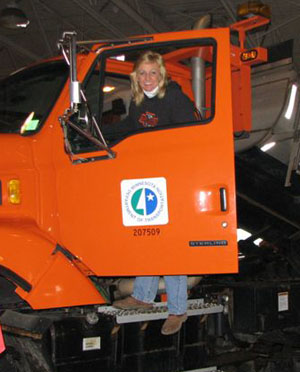By Della Ljungkull

Teri Hadrava climbs out of her snow plow truck in District 2, where she has worked for more than 20 years. Photo by Karen Bedeau |
District 2’s Teri Hadrava has worked for Mn/DOT more than 20 years in various positions. She started out in the Construction section, moved to the Administrative and Permits Office and has now worked in the Maintenance section for nearly five years. Hadrava is responsible for a number of tasks in the East Central Sub-Area of District 2. In addition to inspecting and repairing culverts, maintaining shoulders, sweeping roadways and washing bridges, Hadrava drives a snow plow and works long hours to ensure that Minnesota’s state highways are in the best possible condition for the traveling public.
How long are the shifts? How many breaks do you get?
Our shifts are anywhere from eight hours on up. Depending on the weather, we can be in our trucks for long shifts at times. We never leave the roads covered in snow or ice just because our eight hours are up. We plow until it is safe for the traveling public.
We are scheduled to get two 15-minute breaks and a 30-minute lunch break. Sometimes you drink your coffee on the go or stop and take a quick stretch break so your muscles don’t get too cramped up in the truck. The trucks have much more equipment in them than a person would normally think, so you don’t have much room inside there.
Do you get nervous when you’re plowing?
I really don’t. I’m pretty comfortable with it. You just have to learn everything you can and be careful.
What do you worry about most when plowing?
I worry most that someone will slide into me and get hurt.
Besides driving carefully, what else do you focus on when plowing?
I think that everyone should ride in a plow truck at least once. That way, they would know that besides just driving, we are watching and controlling the plow, underbody scraper, wing, sanders and gauges, not to mention all the traffic around us.
What can motorists do to help you perform your job better?
I can’t stress to the public enough to give the plows room. We might not even be able to see them trying to get by us.
What do your duties consist of when you aren’t plowing?
Our other duties vary per season. We maintain our own snow plow trucks by changing the oil, greasing, inspecting and changing cutting edges on our plow, wing and underbody. When the snow gets too deep in towns, we work night shifts and haul the snow out to other locations.
In the spring, we have trouble with some culverts freezing, which can cause flooding problems. We take a steamer out to open the pipes. The west side of our district has also had some major flooding problems over the years, so we help out with traffic control.
We do culvert inspection, repair and clean out. At times, we have to dig out beaver dams that are causing problems. We do the mowing, shouldering and tree and brush removal on state right of way. We also do guardrail repair, herbicide application and, of course, respond to any emergency on our roadways that need our help.
I have also been asked a few times to take my truck to local schools and explain snow plow safety to the students, show them my truck and answer any questions they might have.
What do you enjoy most about your job?
What I can truly say I enjoy most of all is: I work with a great crew. |



